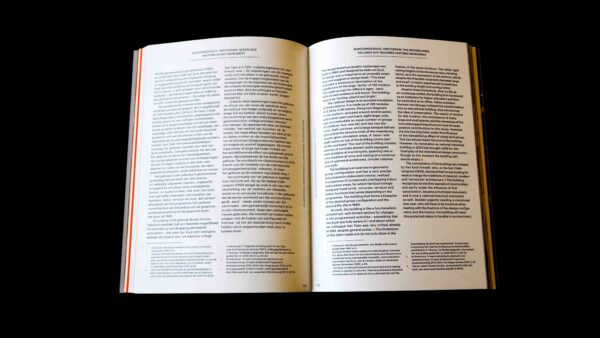Vitale architectuur/Vital Architecture. Gereedschap voor levensduur/Tools for Durability
Vitale architectuur/Vital Architecture. Gereedschap voor levensduur/Tools for Durability
At the core of this book is the subject of architectural sustainability. Twenty buildings — from the Pantheon in Rome to the Zollverein in Essen — are celebrated for their future value as architecture that stand the test of time, also, notably, when their use is changed. Interestingly, the focus of the book is not only on architects and designers, but also on clients and users.
The buildings are described, interpreted and methodologically documented using plans, sections, diagrams and photographs, making it easy for the reader to find and compare information. A most notable feature is that the spatial analysis of both iconic and common buildings is presented in a very consistent way, although the construction period ranges from the beginning of Christianity to our present day. Despite its technical feel, this book is very accessible for anyone, with the use of a bright, almost neon orange colour to highlight sections and make the reading experience generally more exciting. The overall impression is that this book represents something important to hold on to, a very useful manual for future, more sustainable buildings.
- Auteur
- Ruurd Roorda, Bas Kegge
- Oplage
- 1,200
- Omvang
- 224
- Prijs
- 29.95 euro
- ISBN
- 9789462082830
- Verschijningsdatum
- May 2016
- Uitgever / Opdrachtgever
- nai010 uitgevers
- Ontwerper(s)
- Niels Schrader, Amsterdam
- Fotograaf
- Roel Backaert
- Drukkerij
- Epos Press, Zwolle
- DTP / Zetterij
- Niels Schrader
- Lithograaf
- Pieter Reinink (PR Digitaal), Meppel
- Boekbinderij
- Stronkhorst Boekbinders, Groningen
- Materiaal
- Interior: 115 g/m² Fly 05 (Ribberink Agenturen). Cover: 300 g/m² grijskarton, 1z glad (Igepa).
- Lettertype
- Graphik (Commercial Type), Beckett (A2-Type)
- Technische Bijzonderheden
- Gedrukt in 2 overdrukkende PMS kleuren en met 2 full colour katernen aan het begin en einde. Visualisatie-elementen zoals tijdsbalken, miniatuurkaarten en hoogtelijnen maken de besproken architectuurprojecten vergelijkbaar. De fotografie is speciaal gemaakt voor deze uitgave.
At the core of this book is the subject of architectural sustainability. Twenty buildings — from the Pantheon in Rome to the Zollverein in Essen — are celebrated for their future value as architecture that stand the test of time, also, notably, when their use is changed. Interestingly, the focus of the book is not only on architects and designers, but also on clients and users.
The buildings are described, interpreted and methodologically documented using plans, sections, diagrams and photographs, making it easy for the reader to find and compare information. A most notable feature is that the spatial analysis of both iconic and common buildings is presented in a very consistent way, although the construction period ranges from the beginning of Christianity to our present day. Despite its technical feel, this book is very accessible for anyone, with the use of a bright, almost neon orange colour to highlight sections and make the reading experience generally more exciting. The overall impression is that this book represents something important to hold on to, a very useful manual for future, more sustainable buildings.
- Auteur
- Ruurd Roorda, Bas Kegge
- Oplage
- 1,200
- Omvang
- 224
- Prijs
- 29.95 euro
- ISBN
- 9789462082830
- Verschijningsdatum
- May 2016
- Uitgever / Opdrachtgever
- nai010 uitgevers
- Ontwerper(s)
- Niels Schrader, Amsterdam
- Fotograaf
- Roel Backaert
- Drukkerij
- Epos Press, Zwolle
- DTP / Zetterij
- Niels Schrader
- Lithograaf
- Pieter Reinink (PR Digitaal), Meppel
- Boekbinderij
- Stronkhorst Boekbinders, Groningen
- Materiaal
- Interior: 115 g/m² Fly 05 (Ribberink Agenturen). Cover: 300 g/m² grijskarton, 1z glad (Igepa).
- Lettertype
- Graphik (Commercial Type), Beckett (A2-Type)
- Technische Bijzonderheden
- Gedrukt in 2 overdrukkende PMS kleuren en met 2 full colour katernen aan het begin en einde. Visualisatie-elementen zoals tijdsbalken, miniatuurkaarten en hoogtelijnen maken de besproken architectuurprojecten vergelijkbaar. De fotografie is speciaal gemaakt voor deze uitgave.




